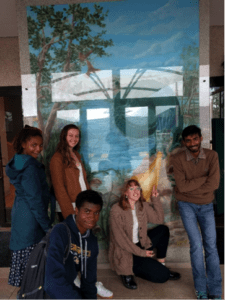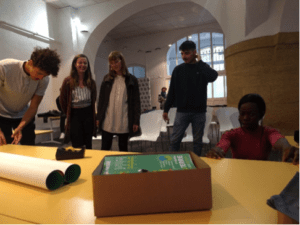Hey, guys, what’s good? Have a good week? Let’s dive right in.
One of trips this week was to 3 separate waste treatment facilities: household garbage, industrial waste, and grey water treatment. The household garbage facility and the grey water treatment are both run by the same entity, Haganis, but each center has different goals. At the center for garbage, their goal is to lessen the impact that garbage has on the environment, to clean it up a little. They try as much as they can to recycle, employing a lot of people to hand sort through the material down conveyor belts. They still practice incineration, but don’t use fossil fuels to fuel the fire; instead, they use organic waste to start and keep the fire burning. As if that wasn’t enough to impress me, they also recycle the ashy material left over from the incineration called “mâchefers”. Most of the ashy materials makeup is metallic, so they run it through a magnetic process; the rest of the material is recycled and becomes roadways or sidewalks. That’s resourceful! I was happy with the amount of times they referenced the environment as reasoning for their actions; it’s one of the pillars of their mission as a waste treatment facility: lessening the environmental impact of our waste.
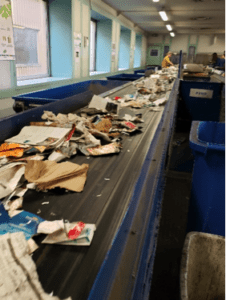
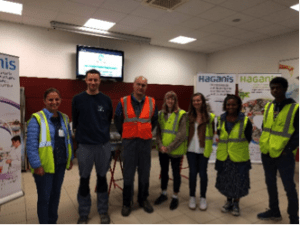
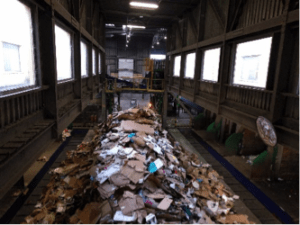
At the Haganis wastewater treatment plant, we got to see how they go about treating all the grey water from people’s homes that arrives there through a large network of pipes. They have a “separated” system, so used water from sinks in the house or washing machines isn’t transported in the pipes with used water from toilets and showers; this helps them keep a majority of the water at a specific level of contamination, instead of further contaminating all of the water that they process. They use gravity to move the water through the pipes towards the facility, utilizing a pump to move the water up over a hill only when necessary. At Haganis, the water is run through a series of basins that aim to decant solid waste and microorganisms and then treat the water for harmful amounts of certain elements (like phosphorous). The system is similar to one that you’d find in the United States, but Haganis, here, takes it one step further than just treating and returning the water to the river. Once they have the “sludge”, the decanted solid materials or dead microorganisms, they can recycle a portion of it instead of burning it all (which I believe is procedure in the United States). They can take the organic waste from the decanter basins and from the basins that remove microorganisms from the water to farms to be used as fertilizer, and they do this extra step for free, without financial incentive. The rest of the sludge is burned or recycled similarly to the mâchefers. At these Haganis facilities, they’re doing their jobs cleaning up the waste that we produce, but they’re also trying to do everything in the light of their environment and what they can do to reuse the waste or lessen the footprint of their facilities’ treatment processes. Pretty inspiring, honestly.


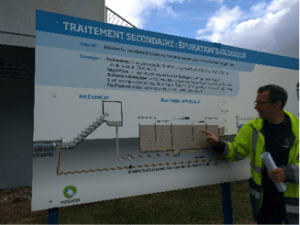
When we made our way to Schroll in Rambas, the industrial waste treatment facility, we got to see what big businesses did with their trash and the kinds of problems that the particular wastes posed for the facility. Paper, for example, isn’t always made so that it’s completely recyclable. There were giant rolls of paper in huge piles just sitting because they must break down each of the rolls to get out the recyclable parts (the thick cardboard roll and the plastic parts of the spindle), and the rest goes to the incinerator. Plastic packaging, the really thin, transparent plastic that’s often used as an outer layer of protection on packages was in the lot in heaps; the facility takes what they can (some plastic packaging is too fragile to be run through machining or extremely harmful to heat up) and heat it up to mold it into “bricks” that can be bought by other companies as recycled plastic material. They do the same thing with cardboard and plastic containers for milk products (for example). Our tour guide, David Lavielle, was transparent throughout the tour, explaining that their process isn’t perfect and that they don’t have any idea what they’re supposed to do with some of the waste that comes through their facility. When all else fails, burn it, but that’s not their goal. They want to be able to properly process and recycle as much as they can, and at the end of the day, it’s our job to help them achieve that. Pay attention to what you buy and use, the makeup of it, the materials that the business uses to make whatever product and stay away from it if it’s mainly composed of non-recyclable materials. The consumer, us, has all the power over businesses and what they produce. If we weren’t buying products that were wrapped 3 times in some harmful, thin plastic packaging, I think the businesses who were suffering from lack of purchases would be hard-pressed not to switch over to organic cardboard or paper packaging.
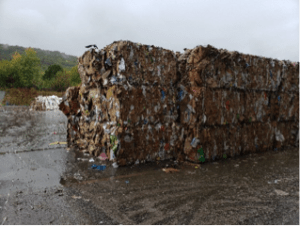

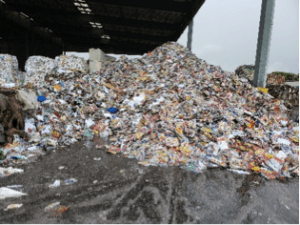
On a different note than waste, we had a meeting with some lovely, fellow French students and the president, Marie-Anne Isler Beguin, and vice president, Catherine Godignon, of the European Institute of Ecology this past week. We came to discuss the logistics of a film festival that they’re hosting for the second time ever called “CinaMaTerre”; at the festival, you can watch films from all over the world from 2017 to now that challenge and demonstrate different environmental issues socially, economically, and, of course, ecologically. We’ll be helping them out with a specific segment “Youth4Planet” which is a short video in which we ask French children what they think we should do in order to help the environment. There was a press conference that the Institute held with the local newspapers in order to promote the event; there, Lindsey Lovitt and I were asked to film short responses (in English, Dr. Kozhanova was a little disappointed, so that we could help illustrate the international aspect of the festival) detailing how we felt about the festival, our impressions of what their goals were. Like I said for their video, I’m really inspired by the efforts that people are going to not only to help the environment in general, but also to spread the knowledge and promote awareness of our impact on the planet. The international aspect is important, too, because we live in a global community, truly, even though that’s easy to forget sometimes. We all need to make an effort to change; our movement is only as strong as our weakest member.



Affecting change on a grand scale, like over the entirety of the United States, would be difficult no doubt, but it’d be a lot easier if everyone was trying instead of relying on one entity’s efforts. The change has to start in what you do at home, in what you buy, in what you eat, and in your heart. It’s hard to see a good reason for why you should change sometimes, even just a habit like chewing your fingernails, but seeing other people with pretty fingernails, for example, might persuade you. Be the person who’s doing good for the environment in your area, spread your knowledge and passion to those around you and we can change the world together.
